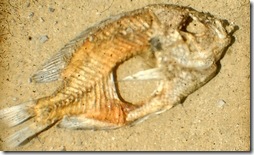 It’s one of those questions that has plagued me for the last couple of years, what happens to fish subjected to the annual torrent of runoff and massive amounts of debris dislodged from upstream.
It’s one of those questions that has plagued me for the last couple of years, what happens to fish subjected to the annual torrent of runoff and massive amounts of debris dislodged from upstream.
The small creeks in my area are scoured badly every year, growing to over a thousand times their normal size in just 24 hours. Hundreds of tons of gravel displaced, old cars tumbling through the watershed, and deadfalls dislocated upstream – to wedge themselves into bridge abutments or anything else that’s anchored.
I suspected the result was bad, having seen lots of abrasions and raw areas on the fish each Spring, but never finding any research on the subject you can only assume that it’s tough for us to breath in a sandstorm, and a fish is likely to have similar issues with floods.
We used radiotelemetry to monitor the movements of adult brown trout Salmo trutta in a New Zealand river over 11 months (September 2004 to August 2006) and linked those movements to the changes in flow and water temperature. Individual fish moved up to 41 km during the study. However, most fish moved less than 1 km. All of the trout that showed little movement throughout the summer were living in relatively deep pools that presumably provided cover. The rates of movement declined steadily over the spring–summer period, as flow decreased and water temperature increased. The percentage of fish moving was positively related to the average daily flow during the interval between tracking occasions and negatively related to the average daily water temperature, less than 20% of the tagged fish moving once temperatures were above 19°C. A severe, 50-year flood occurred in March 2005 and was associated with the mortality of 60–70% of the remaining tagged fish, confirming that flood-induced mortality can affect a substantial proportion of an adult brown trout population.
Only a small nugget to confirm my suspicions, flooding is bad – for them and us. The mention of individual Brown Trout moving as much as 41 km is eye opening, as this is observed behavior unrelated to flooding.
Which may explain why the “Trico” mayfly is the dominant food source locally. Tiny in size and able to re-establish themselves much quicker than large insects that require larger food.
… and among each group of insects, some are able to spread faster than others, based on food source or breeding behavior. An observant fellow, as we all are, would then be able to determine how long before his favorite bug would be back in quantity – based on what he’d seen in past flush cycles.
Completely unscientific, absolute conjecture – but it gives me something to watch – as I love a good mystery.
It’s both the beauty and peril of the Internet, you’re researching one phenomenon and are completely sidetracked when another presents itself…
Tags: Salmo Trutta, New Zealand, tricorythodes mayfly, impacts of flooding on invertebrates, unscientific method, opinion
